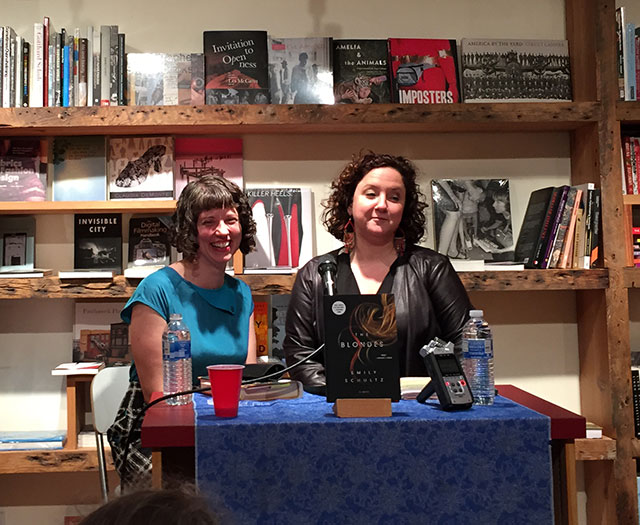
Blonde women become the conveyers of a rabies-like illness in the latest novel by Emily Schultz, The Blondes. Told from the perspective of red headed Hazel speaking her yet unborn child, the novel unfolds over the course of several months as infected blondes violently attack people. Schultz discussed the novel at BookCourt in Brooklyn with Julia Fierro, author of Cutting Teeth.
The two authors joked that they had considered wearing blonde wigs in celebration of the book. Unfortunately, they didn’t. They did talk about hair, though, a central part of the novel.
Hazel has escaped New York City to a remote cabin in Canada. Pregnant with her former professor’s child, she speaks to her child explaining the events surrounding the blonde plague that mysteriously only impacts women. In her remote cabin, she is relatively safe from the plague, but not necessarily from the wife of her child’s father.
“I knew Hazel had to be not from New York,” Schultz says of the character’s Canadian background. Schultz is also Canadian. Hazel is a graduate student when the outbreak begins. She is studying an invented field of Aesthetology, an area focused on advertising, beauty, and language. “I wanted someone who could dissect the media.”

Fierro praises Schultz for achieving so many varieties of story in the novel, particularly the story of motherhood. Fierro explains that for her, as a writer, it took her years to be able to write about the experience.
“She is quite a reluctant mother,” Schultz explains.
The idea for the novel came to Schultz while she was flipping through a magazine. She saw an ad with all these blonde women dressed up for the shoot and suddenly had a sense of fear: “I just thought: ‘they’re gonna getcha,'” she says. Based on the image, she wrote a scene where the rabid blonde women have an attack at JFK Airport.
“I’ve struggled with hair my whole life,” Schultz says. Her hair is naturally dark, but she says she has lived as a blonde before. She says that it can be a lot of fun. “I wanted to look at hair and what it gets us.”
The novel examines beauty and perceptions, but it also looks at the media, and how society handles fear and paranoia. She intentionally elicits fears of terrorism as the disease spreads. Hazel at one point must cross a border where she is subjected to a search–one that Schultz describes as the curtain and drapes test.
Schultz did research on plagues and how they spread for the novel in order to capture accurate responses, but the novel isn’t always serious. Sometimes its playful. Don’t get caught up on the science, though, she warns, saying it might not hold up with too much scrutiny.
Hazel’s pregnancy is a major part of the novel. She ends up telling things to her fetus that is probably not appropriate to tell a child. There are moments that are tongue-in-cheek too, Schultz says. But she also liked the idea of pregnancy because of how it changes the body. “Your body does such insane things,” she explains.
“I felt like I was punishing Hazel,” she adds.
The book balances real emotions with satire. It straddles the line between serious and humorous. Fierro says: “I think there is a lot of authentic emotion.” But there are also blonde women rabidly attacking people on subway platforms.
In recent years, a number of literary novels have dealt with epidemics and diseases. The popularity of these plots is reactionary, Schultz says, as a way of processing post-9/11 trauma. As for The Blondes, part of the excitement is in women being the aggressor. “The idea of women acting violently is kind of terrifying,” Schultz says.